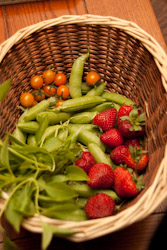Harvesting Vegetables

You’ve designed, planted and tended your garden and now it’s time for the payoff – the harvest. If you’ve planted a variety of crops they will ripen at different times, so you need to walk through the garden several times a week to look for crops ready to be picked. Some crops like lettuce can have a long window for harvest (especially in cooler months) but others such as zucchini or sweet corn must be picked within a fairly short window or they become monstrous or ripen beyond their peak flavor and their quality is diminished. It is best to pick produce in the morning, before they wilt in the afternoon heat. If you must harvest in the evening, you can rehydrate greens in a tub of cool, clean water.
A good pair of pruning or kitchen shears are invaluable for harvesting. They can cut cauliflower, broccoli and squashes or snip greens. Peas, beans and tomatoes can be picked by hand, if you are careful not to pull on the plants and damage them. Use a twisting motion to remove the vegetables.
Once you’ve harvested your crops, you can either enjoy them for dinner or save them for later. Different vegetables have different storage requirements. For example, tomatoes lose flavor and become mushy, if stored in the refrigerator, while greens should be refrigerated as soon as possible to keep them from wilting. Check here for a Complete List of how to store different fruits and vegetables.
If you have more food than you can eat, you can share, trade, donate or preserve your excess harvest by drying, freezing, pickling or canning it. For complete information on preserving the harvest, refer to the National Center for Home Food Preservation. Canning food is easier than you think. Just be sure to follow directions exactly and keep your equipment very clean and you will be able enjoy your harvest well into the winter.
Further Reading:
Further Reading:

